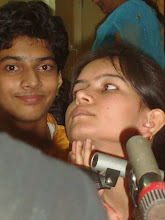Case in point - the recent coverage of the 26 November attacks on Mumbai. Through the first few hours of the coverage of the attacks, every news channel was following the attacks and reporters were doing a commendable job standing outside the places that were attacked and even ducking bullets in the process. But what was not acceptable was the incorrect information that they were passing onto people. An anchor of one of the news channels repeatedly said that there had been attacks at the Metro hospital. The anchor either got the wrong information or had confused Metro Cinema with Cama Hospital (which were indeed under attack) and said Metro Hospital. This could have triggered off a a panic situation if Metro Hospital were in the vicinity of the attacks. The channel later corrected itself but did not apologise for it.
This was just the tip of the iceberg. The next day’s coverage and that of the day after looked like an exercise from the media handbook of ‘What not to do in conflict coverage’. The number of terrorists was proclaimed to be 25 at one point, CST station was again attacked, victims were made to go through third degree question-answer sessions almost immediately after they had been rescued. The electronic media behaved in an irresponsible manner during the coverage. There were some who did good work but the number of mistakes overshadowed their efforts.
This was just one example. There are scores of such cases that can be debated upon like that of Prabhakaran’s body being shown after his death and the Arushi murder case. There are even channels which specialise in 'Doom Reporting' where they talk about the end of world happening soon and all sorts of rubbish. In the end, it is the viewer who suffers. He is the one who is being made a fool. A viewer is only as smart as the content he watches. And if this is the content that is available today on news channels, then can we really blame them for watching channels like India TV?
The main question that the electronic media needs to ask itself is where to draw the line between what is essential and needs to be covered and what is covered for the sake of TRPs and eyeballs. In the race to number one slot and TRP Ratings, television channels are forgetting their duties and the fact that they are answerable not just to the industry but also the entire nation. Editors in TV channels need to be a little bit more involved in the news reporting process than they are at present. It is very clear from the kind of coverage that we see today that there is no higher authority who governs the entire process. They must remember that "The news comes first and the news alone should be their priority."




waahh!! someone has finally arrived and HOW!!
ReplyDeletegreat idea for a post- a little heavy undoubtedly but you've articulated well.. but I'd like to say that your views, however sensible, are still that of a lay-person's.. being someone who studies these things on a daily basis, I'd like to talk about some of the ideas you've expressed.. The entire TRP business you've talked about has essentially been developed upon this one communication theory called 'Uses and Gratification'..what that basically means is that the audience/reader is not a passive but an extremely active participant in the entire programming process..which further means that it is the audiences' who need certain kinds of programmes to gratify their needs of information, social integration and entertainment. This issue links directly to other larger problems like illiteracy and medieval practices in our society..Also, with our media pervading across the country in vernacular forms as well as predominant Hindi and English language forms, it is extremely difficult at the level of governance to employ a particular regulatory authority.. Don't consider this a desperate attempt at defending the faulty nature of the media industry as it has become- all I'm trying to say is that the entire onus can't possibly be made to fall upon the news industry.. the audience has an active choice and a powerful right to exercise as well..
well done though..
proud of you :)
hugs
Thank You Di.. Well Let me confess first that i picked this up from the net and added a few points because i was extremely confident about what the guy was saying!! and i would maybe publish few more posts on the media here itself!! and i fear that most of them would be that of a Critic!! anyways i made a start and followed the Golden Rule of blogging too... hahahaaa..
ReplyDeleteI guess u get me!!